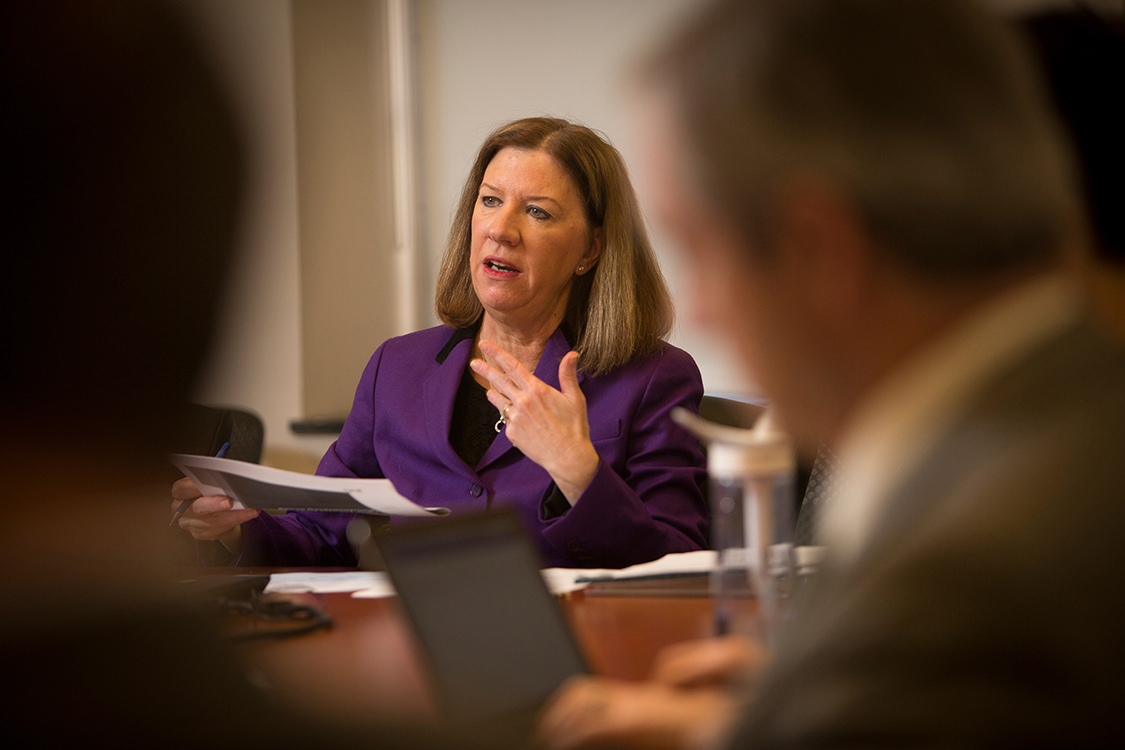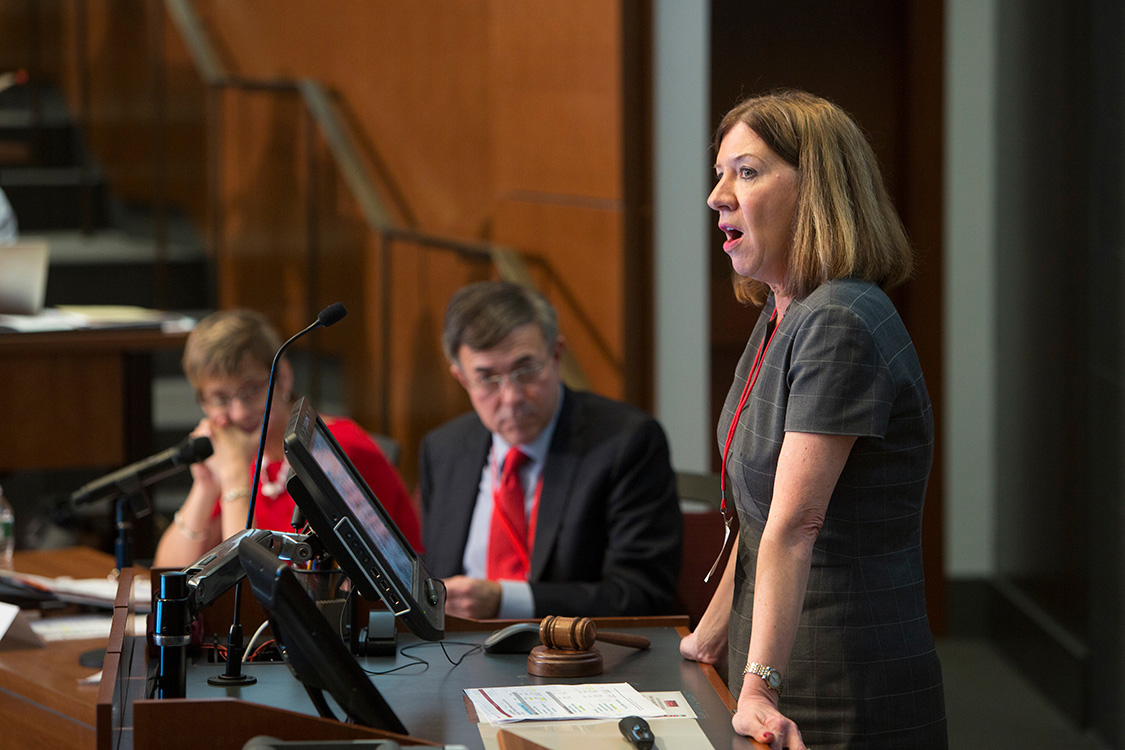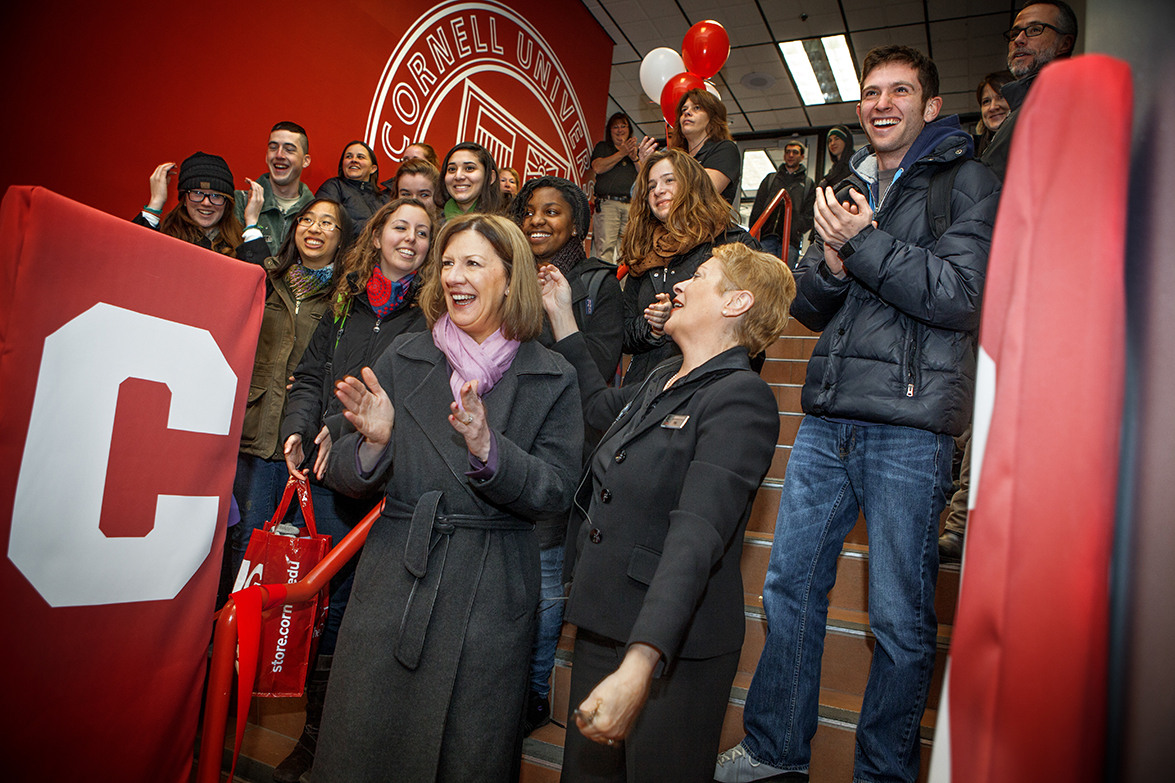DeStefano takes a holistic approach to managing risk
By Joe Wilensky
This past fall, President Elizabeth Garrett expanded Joanne DeStefano’s role as executive vice president and chief financial officer for Cornell, adding infrastructure, risk management, emergency management, environmental health and public safety to her continued oversight of financial affairs and the investment and audit offices (and, with Provost Michael Kotlikoff, shared oversight of information technologies and budget and planning). DeStefano discusses her newly expanded role, the university’s financial challenges and being part of Cornell’s new leadership team.

What do you draw upon to take a big-picture approach to your expanded responsibilities?
As CFO for the past seven years, I’ve spent the majority of my time focusing on risk from a financial perspective. It’s been my number one priority in managing the balance sheet for the university, and so I’ve had to think about, in a five-year forecast, things like liquidity, credit, counterparty and volatility risks. This will be more exciting for me because now I’m broadening beyond the financial risks and thinking more about enterprise risks.
My skill set in evaluating financial risks will help me take a more holistic approach in this area, and I’ve been reaching out to people both internal and external, who have experience in enterprise risk. I’m now taking it all in and designing my own custom approach of how we’ll think about risk institutionally going forward.
The most important thing to remember is that we’re not trying to eliminate risk – we’re just trying to manage it and understand it and make decisions based on a balance between benefits and risk. If you understand your risks, you can make better decisions.
Why did Cornell see the lowest return on its endowment among the Ivies in 2015?
One of the realities of our endowment is that we need to invest for the very long term, and some of our peers who have had higher investment returns invested in vehicles that we didn’t invest in until more recently. The chair of our investment committee and the chief investment officer are identifying ways to focus on some of those areas. They’re looking at how we can get into certain markets more than we have in the past.
What challenges remain facing Cornell stemming from the 2008 financial crisis?
From an institutional, fiscal perspective, we’re still coming out of the crisis. Back in 2008, at the time of the economic crisis, Cornell was fairly highly leveraged, without much available working capital; so at the time the credit crisis started, we didn’t have the flexibility to manage out of that situation. We’ve been fairly conservative since then, in an effort to build up our capacity, outside of the endowment, to manage market fluctuations. So we’re in a much better position today than we were in 2008 or even five years ago.
We have overall balanced budgets, but we still don’t have very much financial flexibility, and in 2009, one of our credit raters, Standard & Poor’s, downgraded us, and they have not upgraded us back to where we were prior to the economic downturn. We are hopeful that our rating will be restored within the next couple of years.

One of the other balance sheet concerns is that our proportion of assets in physical plant is greater than that of most of our peers. About 30 percent of our assets is in bricks and mortar, instead of in endowment or cash or receivables, and that impacts our financial flexibility. And with a larger proportion of physical assets comes the cost of deferred maintenance, which is now a top priority here on the Ithaca campus.
How has managing Cornell’s financial health changed in the 25 years since you joined the university?
The scope and breadth of my responsibility has changed significantly. When I was the general accounting manager for just the contract colleges, I had no corporate fiscal responsibilities; the main focus of my job was to make sure that the state appropriations that we received were spent appropriately and in a timely way. We also had to make sure we followed the New York state rules, which were oftentimes different and stricter than the university rules.
Since that time, the contract and endowed business offices have merged and many financial policies are now universitywide policies. This makes things a lot easier to manage, although the environment is different.
Over these 25 years, we have seen the growth of the federal budget, at least for research, and now we’ve seen a decline; we’ve seen growth in state appropriations, and then they, too, have come back down.
We’re a private university with a land-grant mission and four state colleges. Therefore, we have the most diverse revenue sources of any school in the country. This helps us during the downturns because typically, with six main revenue sources (research, state appropriations, tuition, philanthropy, auxiliary services, clinical programs), it’s unlikely that all six are going to be impacted at the same time.
The most significant change I have seen, though, in the past 25 years, is the university’s growing presence in New York City. In 1990, the medical college represented only 25 percent of total revenues. Today, it’s almost 50 percent, and that’s not counting Cornell Tech. So when we think about the next 25 years, and building out Cornell Tech with an expected 2,000 students in total, the New York City campuses will generate more revenue than the Ithaca campus.
President Garrett strives to keep a Cornell education affordable through financial aid for students. How well have we done?
We’ve done very well; the first initiative started just before the economic downturn, and then while we were facing the downturn, in 2009, President Skorton enhanced the program even further – because he believed it was a priority to keep the cost of education affordable to any qualified applicant who wanted a Cornell education.
For undergraduate students who receive financial aid, the net tuition they are paying, on average, is less today than it was in 2008, in every aided income category. So that’s something that I think Cornell should be really proud of. We’ve had tuition increases every year, though, so the unaided population has seen an increase in the cost of education.

We have good numbers on our student debt, also: The national average for student debt incurred at graduation was $28,000 in 2015; the Cornell average was $23,000, and the median was $16,000. The percentage of undergraduate students borrowing in 2007 was 43, and today it’s 33. On the percentage of students who have debt at graduation, the national average is 69, and we’re now down to 44. I think the initiative and the focus have paid off.
The overall cost of education is an issue. It’s a national issue, and we’re paying attention to it. One of President Garrett’s first memos when she started was about eliminating redundancies across campus to try to be more efficient and less costly in what we’re doing. That effort is partly to help control tuition costs.
How does philanthropy affect Cornell’s daily financial operations?
Philanthropy is extremely important to our fiscal success – particularly now, with our traditional revenue sources constrained. We depend on philanthropy, probably more today than ever before.
I think about how philanthropy contributes to our operations in three areas: the operating budget, which are funds for current use that we actually spend in a given year; facilities, to help with our construction; and gifts to endowment, which are extremely important, because they’re there in perpetuity and the payout is what funds the academic programs.
Since 2009, we’ve been using short-term strategies to balance the budget, which is why we don’t have as much financial flexibility as we would like. One of those strategies has been taking more gifts into current use, which means that we’re spending the funds, instead of allocating them to the endowment. We need to think about our long-term strategy and, as we finish the capital campaign, focus on placing more long-term fundraising into the endowment.
Right now, 75 percent of our endowment payout is used to support academic programs, research, financial aid and professorships. So that’s all academically focused, which is good. Our goal is to continue to enhance the long-term financial strength of the university through building the university’s endowment.
What has it been like working with this new president and new provost?
I think President Garrett is amazing. I love working for her; she is smart, decisive and realistic. The new provost, Michael Kotlikoff, has jumped right in, and it’s hard to believe he’s been the provost only since August. It’s an incredible team. I really enjoy working with both of them, tremendously.
I think it’s going to be an exciting time with this new leadership of the university, and I’m thrilled to be part of it.
Media Contact
Get Cornell news delivered right to your inbox.
Subscribe